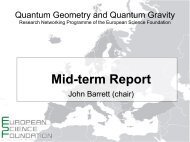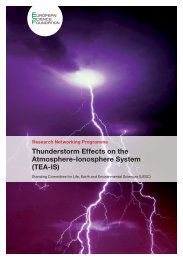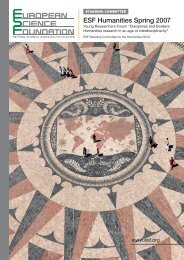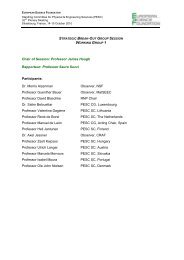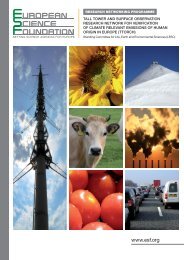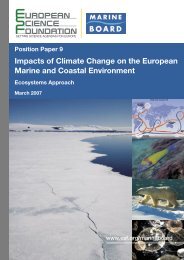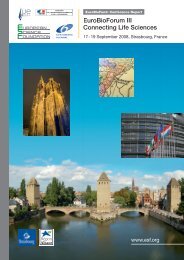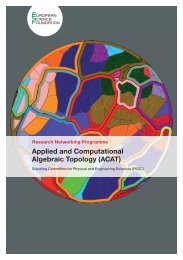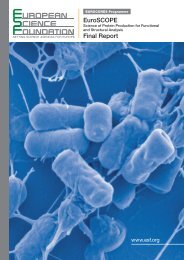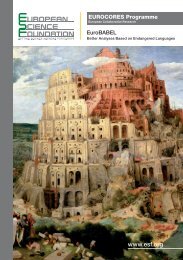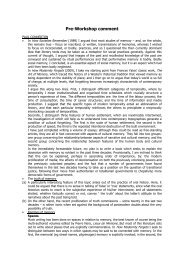European Peer Review Guide - European Science Foundation
European Peer Review Guide - European Science Foundation
European Peer Review Guide - European Science Foundation
You also want an ePaper? Increase the reach of your titles
YUMPU automatically turns print PDFs into web optimized ePapers that Google loves.
6.<br />
Collaborative Research<br />
Programmes<br />
l l l<br />
6.1 Purpose and scope<br />
Collaborative Research Programmes (CRPs) offer<br />
opportunities for groups of scientists, researchers<br />
and, if appropriate, other specialists from the public<br />
and private sectors to join forces in tackling problems<br />
that would require joint actions. They promote<br />
collaborative research targeting broader or more<br />
complex topics of research within or across scientific<br />
domains. In general, collaborative research projects<br />
are in fact larger in size and scope than typical individual<br />
research projects. They must involve several<br />
principal investigators and may sometimes comprise<br />
more than one individual project. Therefore,<br />
CRPs may include projects with more than one set of<br />
research goals, work plans or work packages as they<br />
may also include different budget lines integrated<br />
into a collaborative framework. Moreover, the CRPs<br />
are a particularly appropriate vehicle for supporting<br />
pluridisciplinary research.<br />
There are variations that may influence specific<br />
aspects of the peer review process as elaborated<br />
below:<br />
(ii) National versus multinational<br />
Whether a programme is national or international<br />
can significantly affect the nature of the required<br />
peer review process. The implications can span the<br />
whole life-cycle of the process from beginning to<br />
end. National programmes can be used to:<br />
• Stimulate research within targeted areas with the<br />
goal of enhancing innovation capacities;<br />
• Promote synergies;<br />
• Maintain or enhance research and knowledge base<br />
within the country;<br />
• Promote pluridisciplinary research.<br />
Within a larger context, the above-mentioned targets<br />
can be defined for a group of countries. These<br />
can take the form of bilateral agreements or larger<br />
scale multilateral programmes.<br />
According to the survey, from the 30 respondents,<br />
19 organisations have reported that they have<br />
International Collaborative Research Programmes<br />
while only two indicated they (also) have National<br />
Collaborative Research Programmes 68 .<br />
57<br />
<strong>European</strong> <strong>Peer</strong> <strong>Review</strong> <strong>Guide</strong><br />
(i) Thematic or non-thematic calls<br />
In the former, the themes or topics that are to be<br />
addressed by the project are defined in advance.<br />
The proposed research must therefore fall within<br />
the thematic or topical scope of the call, and the<br />
relevance of the proposal to the call can be an<br />
important measure in the peer review evaluation.<br />
In non-thematic calls, normally, a broad scientific<br />
field or domain of research activity is determined<br />
within which collaboration is to be promoted. The<br />
scope of the proposals can then vary substantially<br />
within that field.<br />
(iii) Responsive (continuous calls) versus nonresponsive<br />
(through solicited and time-bound<br />
calls)<br />
Because of their nature, it is usually preferable to<br />
consider non-responsive mode for managing collaborative<br />
programmes, particularly for multinational<br />
collaborative programmes, since they require specific<br />
preparatory steps that need careful attention<br />
(e.g., programmatic agreements, guidelines, dissemination<br />
needs, themes or domains of research, etc.).<br />
68. See <strong>European</strong> <strong>Science</strong> <strong>Foundation</strong> (2010b), ESF Survey Analysis<br />
Report on <strong>Peer</strong> <strong>Review</strong> Practices, in particular §4.1.2, Table 4.1.



